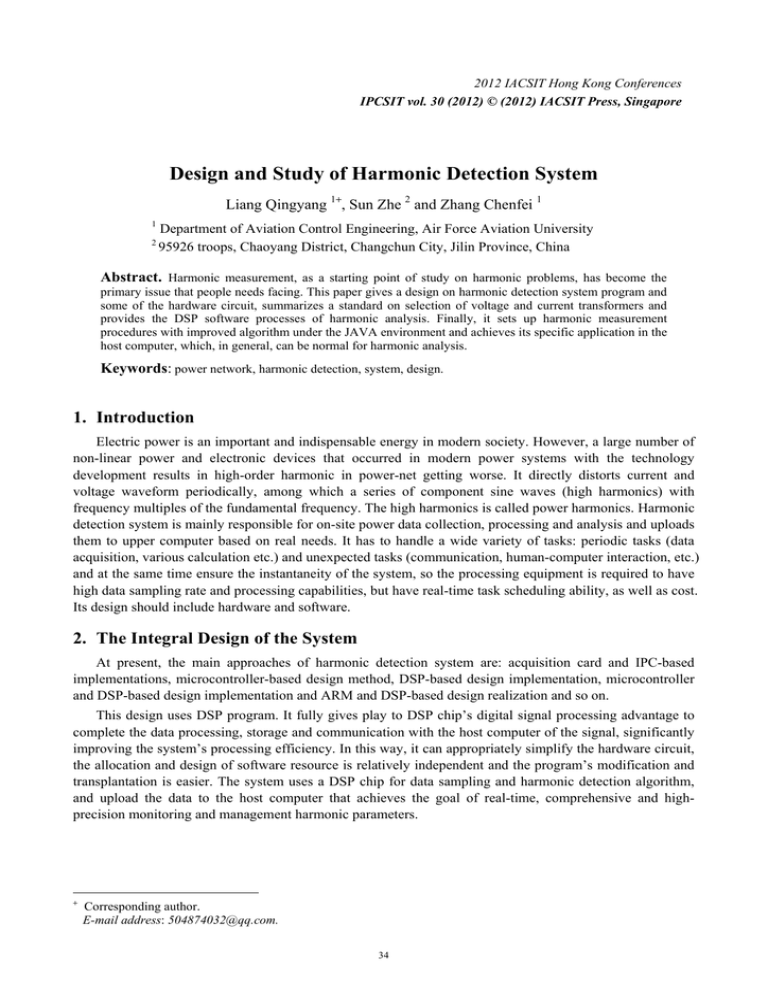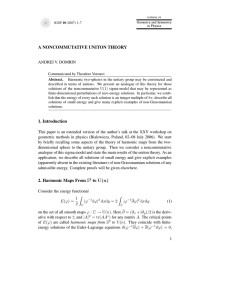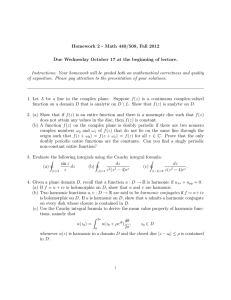Design and Study of Harmonic Detection System Liang Qingyang , Sun Zhe
advertisement

2012 IACSIT Hong Kong Conferences IPCSIT vol. 30 (2012) © (2012) IACSIT Press, Singapore Design and Study of Harmonic Detection System Liang Qingyang 1+, Sun Zhe 2 and Zhang Chenfei 1 1 2 Department of Aviation Control Engineering, Air Force Aviation University 95926 troops, Chaoyang District, Changchun City, Jilin Province, China Abstract. Harmonic measurement, as a starting point of study on harmonic problems, has become the primary issue that people needs facing. This paper gives a design on harmonic detection system program and some of the hardware circuit, summarizes a standard on selection of voltage and current transformers and provides the DSP software processes of harmonic analysis. Finally, it sets up harmonic measurement procedures with improved algorithm under the JAVA environment and achieves its specific application in the host computer, which, in general, can be normal for harmonic analysis. Keywords: power network, harmonic detection, system, design. 1. Introduction Electric power is an important and indispensable energy in modern society. However, a large number of non-linear power and electronic devices that occurred in modern power systems with the technology development results in high-order harmonic in power-net getting worse. It directly distorts current and voltage waveform periodically, among which a series of component sine waves (high harmonics) with frequency multiples of the fundamental frequency. The high harmonics is called power harmonics. Harmonic detection system is mainly responsible for on-site power data collection, processing and analysis and uploads them to upper computer based on real needs. It has to handle a wide variety of tasks: periodic tasks (data acquisition, various calculation etc.) and unexpected tasks (communication, human-computer interaction, etc.) and at the same time ensure the instantaneity of the system, so the processing equipment is required to have high data sampling rate and processing capabilities, but have real-time task scheduling ability, as well as cost. Its design should include hardware and software. 2. The Integral Design of the System At present, the main approaches of harmonic detection system are: acquisition card and IPC-based implementations, microcontroller-based design method, DSP-based design implementation, microcontroller and DSP-based design implementation and ARM and DSP-based design realization and so on. This design uses DSP program. It fully gives play to DSP chip’s digital signal processing advantage to complete the data processing, storage and communication with the host computer of the signal, significantly improving the system’s processing efficiency. In this way, it can appropriately simplify the hardware circuit, the allocation and design of software resource is relatively independent and the program’s modification and transplantation is easier. The system uses a DSP chip for data sampling and harmonic detection algorithm, and upload the data to the host computer that achieves the goal of real-time, comprehensive and highprecision monitoring and management harmonic parameters. + Corresponding author. E-mail address: 504874032@qq.com. 34 Fig. 1: Frame diagram of the system’s whole design After completing the multi-channel signal detection and through signal pre-processing circuit, DSP is to conduct analog digital conversion. It controls high-speed A/D to realize high-speed collection for three voltage and three current channels, then to finish analysis and calculation of the harmonic power indicators, and finally via RS232 and CAN communication interface to transfer the data to the PC machine and with the harmonics analysis software to long-term monitor the power network to identify various problems affecting harmonics. Its monitoring and processing speed is even higher when adopting the advanced digital signal processors and high-speed A/D, better meeting users’ real-time test needs. 3. The Part of Hardware Designed A/D converter is an important device in DSP system. When choosing A/D converter, following performance indicators should be considered: sampling speed, accuracy, interface type converters, power number, packaging, the number of sampling channels and self-contained sample holding condition, etc.. For multi-channel A/D, parameter index in the aspect of sampling simultaneity should also be investigated. Based on this paper, A/D converter only needs to collect low-frequency signal of no more than 6KHz. As in the harmonic data acquisition system, it needs to detect three-phase voltage and current’s asymmetry and power system’s active and reactive power, so the three-phase voltage and current, totally six consumption, are required to sample simultaneously. This article selects TI company's high performance A/D chip ADS to do analog digital conversion. It is a high-speed, low-power, six-channel simultaneous sampling, single +5 V supply, 16 bit high speed parallel interface and high-performance analog digital conversion chip. It loads 2.5V reference voltage source as reference voltage of ADS. Each ADS8 consists of three analog digital converter (ADC) and each ADC has two analog input channels which has a sample holder respectively. Three ADC form into three analog signal input terminals to hold sampling for 6-channel’s input signal simultaneously, and then transferred them one by one. Because the six-channel can be sampled at the same time, it is suitable to the occasion of simultaneously capture multiple signals. When the ADS adopts 5MHz external clock to control conversion, its sampling rate is 250kHz and sampling and conversion can be completed within 20 clock cycles. Its nonmissing code is up to 14 bits, so its total distortion is less than-92dB at 100kHz of input signal. Internal integration differential sampling - hold amplifier is also fully differential input feature for the ADC input, which ensures superior common mode rejection ability of greater than 80dB at the 50kHz input signal and is very important for the application in a noisy environment. As the ADS and the system’s core processing are TI company's products, they can be well connected seamlessly. As DSP is a high-speed device, it needs to pay attention to the timing of the matching problem when choosing SRAM. If the speed of selected device is slow, the situation of data delivery has completed when the last data hasn’t been processed yet, resulting in data loss. This design adopts company ISSI as an external memory. When the DSP working at 40MHZ, the minimum access time is 10ns, which is able to meet the DSP's read and write speed. It uses, in this system designs, the program and data memory reuse design and use to complete the selection of these two spaces. 4. System’s Software Design 35 Modular design concept is applied in the DSP software design process, which is divided into the following main modules: DSP and peripheral initialization and self-test (mainly including DSP instructions, timer, interrupt, internal RAM, external extended RAM, external program memory FLASH and A/D converter), AD acquisition module, data computing module and HPI data communications. This makes the software structure clean, allocation of resources reasonable, good readability and ease of maintenance. Its main program block diagram is shown in Figure 2. Fig. 2: DSP host programming design Data acquisition module’s main task is data collection, storage and processing. When the initialization procedure completed the ADS sampling frequency, DSP's McBSP interface mode and ADS FIFO configuration, it writes ADS control words on its working condition. When timer interrupt, ADSbegins to convert data, and after which to send the conversion results of each channel’s voltage and current to DSP through the serial port. After A/D conversion finish, the conversion result EOC signal generated and interrupt ends. DSP’s data acquisition unit block diagram is shown in Figure 3. Fig. 3: DSP data acquisition program design Data ccomputing module mainly processes the discrete signal received by acquisition unit, and by using FFT algorithm to analyze and calculate harmonic indicators of all power network. 36 Pay attention to the intermediate results overflow when implement FFT algorithm. Process the intermediate values to be normalized and avoid reducing the computational accuracy. Only normalize the number of possible overflow. Make full use of various hardware and software resources when implement FFT algorithm. Such as: (1) make full use of in-chip resources. when the FFT algorithm operates entirely inchip, it can improve the speed of operation greatly. (2) bit-reversed addressing mode. This addressing mode is designed for DSP FFT computing. (3) parallel instructions. Use parallel instructions in the actual C24x programming can save the program runs time and improve code efficiency. (4) as the general engineering data are real numbers, and FFT is complex operation, converting the real data of AD acquisition into plural operation form of real part plus imaginary part to conduct calculation can improve the operating efficiency about twice. The host computer is used to process the signal of DSP sample. This paper, based on JAVA environment, developed a harmonic analysis platform. Restore the data communicated from the lower machine to the original waveform, develop the harmonic analysis software by using the algorithm proposed in chapter five and through the harmonic analysis, achieve for the calculations of harmonics indicators. 4.1. Open the file and select the data file needed to analyze. Based on COMTRADE standard, recorded data file format is arranged according to the chronological order of sampling, including sampling sequence number, sampling time (ms), analog channel data and switching value channel data, etc.. 4.2. Curve show design Open the recorded data file. First read the power system frequency, sampling frequency number, sampling frequency rate and sampling values numerical in the configuration file (* CFG), then read the corresponding channel’s data according to the enter number, including units in each of the selected channel and conversion factor and so on. Due to the analog channels data stored in data files are not the actual values, it must be converted before receiving the actual value of voltage or current. In the configuration file, the conversion factor a and b in each channel have been given, so the actual sampling value in the channel can be gained as long as the data in the data file by the conversion factor a and then multiply b. The actual sampling value is a discrete points set, and graphic based on these points is similar to sine curve, thus the curve fitting least square method is used in this paper. 5. Conclusion Harmonic measurement, as a starting point of study on harmonic problems, has become the primary issue that people needs facing. This paper gives a design on harmonic detection system program and some of the hardware circuit, summarizes a standard on selection of voltage and current transformers and provides the DSP software processes of harmonic analysis. Finally, it sets up harmonic measurement procedures with improved algorithm under the JAVA environment and achieves its specific application in the host computer, which, in general, can be normal for harmonic analysis. 6. References [1] Wang Zhao-an; Yang Jun; Liu Jin-jun. Harmonic Suppression and Reactive Power Compensation, Beijing, China Machine Press, 2009.1. [2] Lin Hai-xue; Sun Shu-qin. Harmonic in Electric Power-Net, Beijing, China Electric Power Press, 2008.4. [3] Lv Run-yu. High Order Harmonics in Power System, Beijing, China Electric Power Press, 2008.5. [4] Sutherland P E. Harmonic Measurements in Industrial Power System. IEEE Trans on IA, 2005,31(1):175-183. [5] Wu Jing-chang. Harmonics in Electrical Power Systems, Beijing, Publishing House of Electronics Industry, 2008. [6] Zhang Fu-sheng; Geng Zhong-xing; Ge Yao-zhong. FFT Algorithm with High Accuracy for Harmonic Analysis in Power System, Proceedings of the CSEE, 2009. [7] Su Bian-ling; Zhu Zhi-ping; Luo Wei-ling. The Harmonic Analysis to the Electric Power Signals Based on the Conbination Wavelet, Journal of Weinan Teachers College, 2005.3, Vol.20, No.2, P39-42. [8] Willems J L.A New Interpretation of the Akagi-Nabae Power Components for Nonsinusoidal Three-phase Situations. IEEE Trans.Instrum.Meas.,2007,41(4):523-527. 37





